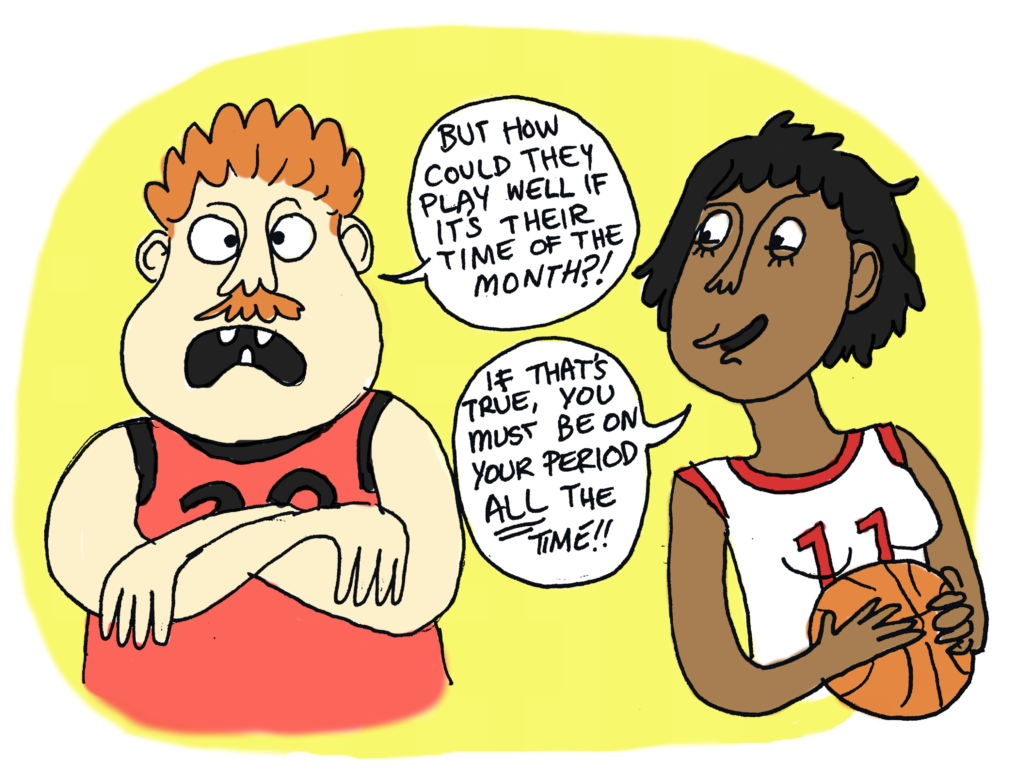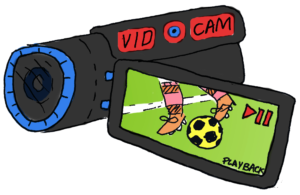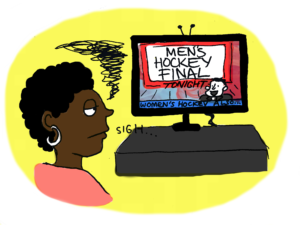Belle Riley Thompson explores the issue of the inequality in coverage between men’s and women’s sports, and how this has effected Carleton’s athletes.
Last year was a historic year for the Carleton University Ravens women’s basketball program—an unbeaten season, and a first-ever national championship. Nicole Gilmore, now a fifth-year member of the team, experienced the high of victory with teammates she had been playing with for years.
But, with the men’s team missing out on a seventh consecutive championship, suddenly the big story was not the women’s win, but the men’s loss.
Gilmore said this inequality and coverage and attention is something she and her teammates are well aware of.
“We all see it. We aren’t blind—like again, the whole Capital Hoops thing. I think last year was the first year we had a bus that left before our game started. But even with that step, the place was still empty.” – Nicole Gilmore, fifth-year Ravens women’s basketball
To combat barriers in sports, former Ontario Premier Kathleen Wynne pledged to increase opportunities for women and girls in sport in 2017.
“Improving women and girls’ participation in sport has benefits beyond the sport and recreation sector,” Wynne said in a press release.
“It can lead to higher self-confidence, better grades and enhanced career opportunities. Ontario is calling on all sport organizations across the province to match the province’s commitment to promoting equal and fair opportunities for women and girls in sport and recreation.”
In 2016, the provincial government invested $1.3 million to advance opportunities for women and girls across the province.
One of the areas where this inequality is most present is in the different levels of coverage between men’s and women’s sports in the media.
By the numbers
A study called “It’s Dude Time!,” written by several researchers studying sports media coverage in the U.S., published their findings in 2015. According to the study, they found that the quantity of coverage of women’s sports, both televised and in news is “dismally low.”
Over that period, researchers also observed that while coverage that focused on female athletes’ sexuality declined in that period, this meant overall coverage did as well.
Katie Lebel, associate professor of business management at Ryerson University, says it all starts with how female sports are advertised. “Women [athletes] are not leveraged in the same way [as men], if a women’s sporting event were to receive the same advertising, it would be important. The way promotional strategies are leveraged,” Lebel said.
Ryerson University is conducting a study to learn more about the inequalities surrounding news sport coverage in Canada on Twitter.
“We have found really alarming statistics,” Lebel said. “Initial results are about 90 per cent skewed towards men’s sports on a platform (Twitter) that does not really have any space restriction like a broadcast medium might . . . It is severely disproportionate to male coverage,” she said.
Ontario University Athletics (OUA) is looking into how they can contribute to equality for women in sports.
“The OUA has a policy in regards to how they provide media coverage for all of our sports,” said Angela Orton, special projects manager. “The platforms we have for reporting and profiles and articles are all equitable between male and female sports with the OUA.”
However, local and mass media does not have the same regulations and committees as the OUA.
Missing the Mark
Ravens alumnus Heather Lindsay played basketball from 2013-2018, winning a championship in her final year with the team. She said despite the success the team had in her final year, there was still a distinct lack in coverage in comparison with the men’s team.
“After the Capital Hoops Classic game, when I opened the sports section the next morning in the local papers, [they] didn’t even publish the score from the women’s game, but posted a one-page spread on the history of the men’s basketball games at Capital Hoops from the last 10 years.” – Heather Lindsey, Ravens women’s basketball alumni, said in an email.
“Carleton and Ottawa U were two of the best women’s basketball teams in the country, and they completely disrespected us as athletes.”
Describing this experience as “motivating for the team,” Lindsay said she decided to take matters into her own hands.

“I went public with it and tweeted out about the lack of respect that we were shown and it managed to get hundreds of retweets and favourites,” she said.
“Shortly after that, I was contacted by different media sources about what had happened and what needs to happen and I voiced that we deserve to be shown equality.”
“It’s a shame that the local media ignored reporting on the women’s game last which also featured two of the best teams in the country. A whole page spread in the paper on the men’s game & nothing about the women. It’s a setback for women’s sports,” reads Lindsay’s tweet.
Lindsay says after her call to action, not only did she and her team receive more attention, she also received apologies from journalists.
“After we won nationals, I was contacted by many journalists who apologized for the lack of coverage and said that they will do their best to right this wrong,” she said. “I only hope they are able to follow through with that, for the sake of women’s sports.”
Ellen Spannagel, Carleton’s women’s rugby team captain, said the sexism she experienced playing have largely stemmed from the stigma surrounding women in sports.
“I have also encountered the idea that girls wouldn’t be able to handle the aggression the same way a man would,” Spannagel said.
She described these experiences with encountering sexism as “frustrating and discouraging.”
Spannagel said an increase in equal media representation could help shift the culture of unrecognized female athletics.
“More representation means more participation and support for the growth in women in sport and the successes they are achieving every day,” Spannagel said.
Moving Forward
The OUA is also making strides to create a more equitable environment for female athletes.
Orton said the association currently established a new women in sport committee, with the first meeting having happened in September.
“The OUA is looking to be proactive and looking at how can we effect some change? How can we develop an overall marketing strategy for women in sports? We feel that we have to intentionally populate and provide the media with human interest stories and things they want to cover,” Orton said.
Whether they are assembling research teams or advocacy committees, women in all sectors of sports are making themselves heard. When women’s achievements are silenced or underrepresented, Lindsay says that silence perpetuates a dangerous sentiment.
“What message does that tell little girls? No matter how good you get at sports you will never be as good or as notable as your male counterparts.” – Heather Lindsay.
Lindsay herself has pushed past the hard times and “used it to fuel the fire,” she says. Lindsay now plays professional basketball in Germany.
Spannagel echoed similar fears to Lindsay’s and hopes more action will change the lack of support female athletes receive in the media.
“It’s so important for the girls of the future hoping to play rugby to see a part of themselves in their heroes in the media and know their goals are achievable,” said Spannagel.






